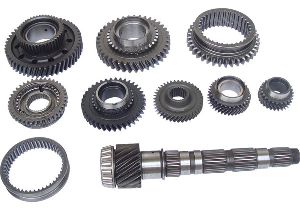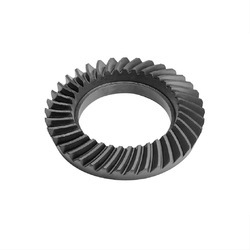Product Description
Engine Variable Valve Timing (VVT) Sprocket
FEATURES:
- Upgraded replacement – this VVT sprocket directly replaces the original equipment on certain Ford, Lincoln and Mercury vehicles
- Enhanced reliability – features stronger alloy plate and friction-reducing rotor design to prevent future failure
- Hardware included – comes with torque to yield bolt for secure fit
- Quality engineering – designed in the United States and backed by decades of automotive CHINAMFG experience
SPECIFICATIONS:
- California Proposition 65: WARNING: Cancer and Reproductive Harm
- Color: Silver
- Item Grade: Standard Replacement
- Material: Steel
- Overall Height (in): 1.76 In.
- Overall Length (In): 5 In.
- Package Contents: 1 Cam Phaser
This item may interchange to the following part numbers from other brands. This is provided for reference only and does not guarantee that the part your are buying is identical to the part numbers from the brands listed below. To confirm that this part fits your vehicle, enter your vehicles Year, Make, Model, Trim and Engine in the Compatibility Table.
- BWD VV5
- Standard Motor Products S21
Original equipment camshaft phasers often fail due to excessive internal wear. This CHINAMFG camshaft gear features a stronger alloy plate and improved rotor design to reduce friction and increase reliability. The variable valve timing sprocket is key to ensuring an engine’s performance and clean running. Replace a worn factory VVT sprocket with this quality engineered sprocket to restore lost performance. Designed to install and perform like the original.
Additional Specifications:
Overall Length (In): 5 In.
OEM Interchange: 3L3E6C524FA, 3L3Z6256DA, 3L3Z6256EA, 3L3Z6256FA, 3R2Z6A257AA, 3R2Z6A257DA
Overall Height (in): 1.76 In.
Material: Steel
Color/Finish: Silver
Retail MAP: 114.95
ProductDesc: The variable valve timing sprocket is key to ensuring an engine’s performance and clean running. Replace a worn factory VVT sprocket with this quality engineered sprocket to restore lost performance. Designed to install and perform like the original.
Fits: 04-10 CHINAMFG F-150, 04-11 CHINAMFG Lobo, 05-14 CHINAMFG Expedition, 05-10 CHINAMFG F-250 Super Duty, 05-10 CHINAMFG F-350 Super Duty, 05-10 CHINAMFG Mustang, 05-14 Lincoln Navigator, 06 CHINAMFG Econoline, 06-10 CHINAMFG Explorer, 06-08 Lincoln Mark LT, 06-10 Mercury Mountaineer, 07-10 CHINAMFG Explorer Sport Trac, 10 Lincoln Mark LT
/* January 22, 2571 19:08:37 */!function(){function s(e,r){var a,o={};try{e&&e.split(“,”).forEach(function(e,t){e&&(a=e.match(/(.*?):(.*)$/))&&1
| After-sales Service: | N/a |
|---|---|
| Warranty: | 1 Year |
| Car Make: | Ford |
| Engine Type: | Vvt |
| Car Model: | 04-10 Ford F-150, 04-11 Ford Lobo, 05-14 Ford Expe |
| Classification: | Engine Variable Valve Timing (Vvt) Sprocket |
| Samples: |
US$ 40/Piece
1 Piece(Min.Order) | |
|---|
| Customization: |
Available
| Customized Request |
|---|
What are the advantages and disadvantages of automatic and manual transmissions?
Automatic and manual transmissions each have their own set of advantages and disadvantages. Here’s a detailed explanation:
Automatic Transmissions:
Advantages:
- Ease of Use: Automatic transmissions are easier to operate since they do not require the driver to manually engage gears. This makes them more convenient, especially in heavy traffic or during long commutes.
- Smooth Shifting: Automatic transmissions provide smooth and seamless gear shifts, as the shifting process is controlled by the vehicle’s computer system. This results in a comfortable driving experience.
- Improved Fuel Efficiency: Modern automatic transmissions often feature advanced technologies such as continuously variable transmissions (CVT) or dual-clutch transmissions (DCT), which can optimize fuel efficiency by selecting the most appropriate gear ratio for the driving conditions.
- Reduced Driver Fatigue: With automatic transmissions, drivers can focus more on the road and other aspects of driving, as they don’t need to manually shift gears. This can reduce driver fatigue, especially during long journeys.
Disadvantages:
- Higher Cost: Automatic transmissions tend to be more expensive to manufacture and repair compared to manual transmissions, which can result in higher vehicle purchase prices and maintenance costs.
- Less Control: Some driving enthusiasts prefer manual transmissions because they offer more control over gear selection, allowing for a more engaging driving experience. Automatic transmissions, on the other hand, limit the driver’s ability to choose specific gear ratios.
- Lower Power Transfer Efficiency: Automatic transmissions can have slightly lower power transfer efficiency compared to manual transmissions, which means that some engine power is lost during the transmission of power from the engine to the wheels.
Manual Transmissions:
Advantages:
- Greater Control: Manual transmissions provide the driver with full control over gear selection, allowing for precise shifts and the ability to match engine RPM to driving conditions. This control can enhance the driving experience, especially for those who enjoy a more engaged and sporty driving style.
- Improved Power Transfer Efficiency: Manual transmissions generally have higher power transfer efficiency compared to automatic transmissions. This means that a greater percentage of engine power reaches the wheels, resulting in better acceleration and responsiveness.
- Lower Maintenance Costs: Manual transmissions are typically less complex and have fewer components compared to automatic transmissions. Consequently, they often require less maintenance and can be more cost-effective to repair.
Disadvantages:
- Requires Skill: Operating a manual transmission requires learning how to engage gears, coordinate clutch and throttle control, and shift smoothly. This can be challenging for drivers who are not accustomed to manual transmissions or prefer a more relaxed driving experience.
- Increased Physical Effort: Maneuvering a clutch pedal in stop-and-go traffic or during long drives can be physically tiring, especially in situations that require frequent gear changes.
- Steeper Learning Curve: Learning to drive a manual transmission vehicle effectively takes time and practice. It requires developing a feel for the clutch engagement point and mastering the coordination between the clutch, gear lever, and accelerator pedal.
Ultimately, the choice between automatic and manual transmissions depends on personal preference, driving conditions, and driving style. Automatic transmissions offer convenience and ease of use, while manual transmissions provide greater control and a more engaging driving experience.
What is the purpose of a differential gear in an automobile?
A differential gear in an automobile serves several important purposes. Here’s a detailed explanation:
1. Differential Action:
The primary purpose of a differential gear is to allow the wheels of an automobile to rotate at different speeds while receiving power from the engine. This is necessary when the vehicle is taking a turn, as the wheels on the outer side of the turn need to cover a greater distance and rotate faster than the wheels on the inner side.
2. Smooth Cornering:
By enabling the wheels to rotate at different speeds during a turn, the differential allows for smooth and controlled cornering. It prevents the tires from scrubbing and dragging along the road surface, which could lead to excessive tire wear and poor handling. Instead, the differential ensures that each wheel can rotate freely at the appropriate speed, maintaining traction and stability.
3. Power Distribution:
The differential also plays a crucial role in distributing power from the engine to the wheels. In a rear-wheel-drive vehicle, the differential is located on the rear axle, and it splits the engine torque between the two rear wheels. In a front-wheel-drive vehicle, the differential is integrated into the transaxle, transferring power to the front wheels.
4. Traction Enhancement:
Another function of the differential is to improve traction. When one wheel encounters a low-traction surface, such as ice or gravel, the differential allows power to be redirected to the wheel with better grip. This helps maintain traction and prevents wheel spin, allowing the vehicle to move forward more effectively in challenging driving conditions.
5. Compensation for Uneven Surfaces:
When driving on uneven surfaces, such as rough terrain or potholes, each wheel may experience different levels of vertical movement. The differential gear compensates for these variations in wheel movement, allowing the wheels to maintain contact with the ground and providing a smoother ride.
6. Reduction of Stress and Wear:
The differential helps reduce stress and wear on drivetrain components. By allowing the wheels to rotate at different speeds, it helps distribute the load evenly across the drivetrain, minimizing strain on components such as axles, driveshafts, and gears.
In summary, the differential gear in an automobile enables smooth cornering, power distribution, traction enhancement, compensation for uneven surfaces, and reduction of stress and wear on drivetrain components. It plays a vital role in ensuring optimal performance, handling, and stability of the vehicle.
What are the common types of automobile transmissions available?
There are several common types of automobile transmissions used in vehicles. Here’s a detailed explanation:
1. Manual Transmission: Manual transmissions, also known as “stick shift” or “standard” transmissions, require the driver to manually shift gears using a clutch pedal and gearshift lever. They typically have a set of forward gears, including first, second, third, fourth, and fifth (or sixth) gears, along with a reverse gear. Manual transmissions offer direct control over gear selection and are often preferred by enthusiasts for their engagement and control.
2. Automatic Transmission: Automatic transmissions use a torque converter and a complex system of planetary gears to automatically shift gears without driver intervention. They are the most common type of transmission in modern vehicles. Automatic transmissions provide smooth and convenient operation as they automatically select the appropriate gear ratio based on factors such as vehicle speed, engine load, and driver input. They typically offer “Drive” (D) mode for normal driving and may include additional modes like “Sport” (S) or “Economy” (E) for different driving preferences.
3. Continuously Variable Transmission (CVT): CVT is a type of automatic transmission that offers an infinite number of gear ratios within a specific range. Instead of using traditional gears, CVTs use a system of belts or chains and pulleys to provide seamless gear ratio changes. CVTs are known for their smoothness and fuel efficiency as they keep the engine operating at its most efficient RPM. They are commonly found in smaller vehicles and hybrid cars.
4. Dual-Clutch Transmission (DCT): DCT combines features of both manual and automatic transmissions. It uses two separate clutches for odd and even gears, allowing for quick and smooth gear shifts without interrupting power delivery. One clutch handles the current gear, while the other anticipates and prepares the next gear for engagement. DCTs provide fast and precise gear changes, making them popular in high-performance and sporty vehicles.
5. Automated Manual Transmission (AMT): AMT, also known as “Semi-Automatic Transmission” or “Clutchless Manual Transmission,” is essentially a manual transmission with automated clutch and gear shifting. Unlike traditional automatic transmissions, AMTs do not have a torque converter. Instead, they use actuators to control the clutch and gear selection based on the driver’s input or pre-programmed settings. AMTs are cost-effective alternatives to conventional automatic transmissions and are commonly found in entry-level or budget-friendly vehicles.
6. Sequential Manual Transmission (SMG) and Dual-Clutch Sequential Transmission: Sequential transmissions are commonly used in high-performance and racing vehicles. They allow for quick and precise sequential gear shifting without the need for a clutch pedal. SMGs use a single clutch, while dual-clutch sequential transmissions operate similarly to DCTs, with two clutches for improved performance and faster gear changes. Sequential transmissions provide rapid gear shifts, enhanced control, and are often controlled via paddle shifters mounted on the steering wheel.
These are some of the most common types of automobile transmissions available. Each type has its own advantages and characteristics, catering to different driving preferences, performance requirements, and fuel efficiency goals.
editor by Dream 2024-04-22




